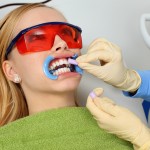
Tooth whitening is an increasingly popular cosmetic treatment. In surgery bleaching and dentist-prescribed, home-applied bleaching are the two most common procedures. Light activation using a range of light sources, halogen curing lights, xenon–halogen lights, plasma arcs, light emitting diodes (LEDs), LED plus lasers, and lasers have been used to reduce the bleaching time and decrease tooth sensitivity. However, studies have produces conflicting results. The aim of this review was to assess the effect of light activation on tooth bleaching and tooth sensitivity.
What did they do
The Medline, Embase and Cochrane Central databases were searched with no language restrictions. Only vital in-office bleaching systems were included. Randomised controlled trials (RCTs) or quasi-RCTs comparing light activated bleaching systems with non-activation bleaching system were included. Reports without clinical data concerning bleaching efficacy or tooth sensitivity were excluded. Data was abstracted independently by two reviewers and Quality was using the Cochrane risk of bias criteria. The main outcome measures were tooth whiteness measured by visual colour matching and/or instrumental measurement and Tooth sensitivity was assessed using a visual analogue scale (VAS), a verbal scale or as a percentage of patients with tooth sensitivity.
What did they find
- Eleven studies ( 9 RCTs, 2 controlled trials) were included in the meta-analysis. Five RCTs had low risk of bias, four RCTs a moderate risk.
- With lower concentrations of hydrogen peroxide (15–20% HP): A light-activated system produced better immediate bleaching effects than a non-light system (mean difference [MD], -1.78; 95% confidence interval [CI]: [-2.30, -1.26]; P < 0.00001).
- With high concentrations of HP (25– 35%); there was no difference in the immediate bleaching effect (MD, -0.39; 95% CI: [-1.15, 0.37]; P = 0.32) or short-term bleaching effect (MD, 0.25; 95% CI: [-0.47, 0.96]; P = 0.50) between the light-activated system and the non-light system.
- However, the light-activated system produced a higher percentage of tooth sensitivity (odds ratio [OR], 3.53; 95% CI: [1.37, 9.10]; P = 0.009) than the non-light system during in-office bleaching.
They concluded
Light increases the risk of tooth sensitivity during in-office bleaching, and light may not improve the bleaching effect when high concentrations of HP (25–35%) are employed. Therefore, dentists should use the light-activated system with great caution or avoid its use altogether. Further rigorous studies are, however, needed to explore the advantages of this light-activated system when lower concentrations of HP (15–20%) are used.
He LB, Shao MY, Tan K, Xu X, Li JY. The effects of light on bleaching and tooth sensitivity during in-office vital bleaching: A systematic review and meta-analysis. J Dent. 2012 Apr 20. [Epub ahead of print] PubMed PMID: 22525016.
Related reviews
Buchalla W, Attin T. External bleaching therapy with activation by heat, light or laser-a systematic review. Dent Mater. 2007 May;23(5):586-96. Epub 2006 Jul3. Review. PubMed PMID: 16820199.
Hasson H, Ismail A, Neiva G. Home-based chemically-induced whitening of teeth in adults. Cochrane Database of Systematic Reviews 2006, Issue 4. Art. No.: CD006202. DOI: 10.1002/14651858.CD006202.
